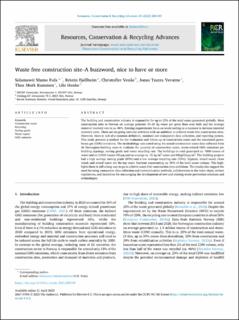| dc.contributor.author | Fufa, Selamawit Mamo | |
| dc.contributor.author | Fjellheim, Kristin | |
| dc.contributor.author | Venås, Christoffer | |
| dc.contributor.author | Vevatne, Jonas Tautra | |
| dc.contributor.author | Kummen, Thea Mork | |
| dc.contributor.author | Henke, Lilo Maria Keti | |
| dc.date.accessioned | 2023-05-02T06:32:06Z | |
| dc.date.available | 2023-05-02T06:32:06Z | |
| dc.date.created | 2023-04-28T09:58:35Z | |
| dc.date.issued | 2023 | |
| dc.identifier.citation | Resources, Conservation & Recycling Advances (RCR Advances). 2023, 18 . | en_US |
| dc.identifier.uri | https://hdl.handle.net/11250/3065658 | |
| dc.description.abstract | The building and construction industry is responsible for up to 25% of the total waste generated globally. Most construction sites in Norway on average generate 40–60 kg waste per gross floor area built and the average material recovery rate is ca. 46%. Existing requirements focus on waste sorting as a measure to increase material recovery rates. There are on-going national activities with an ambition to achieve waste free construction sites. However, there is lack of a common definition, standard and transparent data collection, and reporting system. This study presents a method for the evaluation and follow-up of construction waste and the associated greenhouse gas (GHG) emissions. The methodology was tested using the actual construction waste data collected from 36 Norwegian building cases to evaluate the quantity of construction waste, waste-related GHG emissions per building typology, sorting grade and waste recycling rate. The buildings in total generated ca. 7800 tonnes of waste and ca.12900 tonnes CO2eq and on average ca. 51 kg/m2 waste and 88kgCO2eq/m2. The building projects had a high average sorting grade (89%) and a low average recycling rate (32%). Gypsum, mixed wood, clean wood, and mixed waste are the top waste fractions representing ca. 56% of the total waste volume. This highlights there is still a long way to go to achieve waste free construction sites ambitions. The results also suggest the need for using transparent data collection and communication methods, collaboration in the value chain, stricter regulations, and incentives for encouraging the development of new and existing waste prevention solutions and technologies. | en_US |
| dc.language.iso | eng | en_US |
| dc.publisher | Elsevier | en_US |
| dc.rights | Attribution-NonCommercial-NoDerivatives 4.0 Internasjonal | * |
| dc.rights.uri | http://creativecommons.org/licenses/by-nc-nd/4.0/deed.no | * |
| dc.subject | Construction waste | en_US |
| dc.subject | Recycling | en_US |
| dc.subject | Sorting grade | en_US |
| dc.subject | Waste report | en_US |
| dc.subject | GHG emission | en_US |
| dc.title | Waste free construction site - A buzzword, nice to have or more | en_US |
| dc.title.alternative | Waste free construction site - A buzzword, nice to have or more | en_US |
| dc.type | Peer reviewed | en_US |
| dc.type | Journal article | en_US |
| dc.description.version | publishedVersion | en_US |
| dc.rights.holder | © 2023 The authors | en_US |
| dc.subject.nsi | VDP::Teknologi: 500 | en_US |
| dc.source.pagenumber | 10 | en_US |
| dc.source.volume | 18 | en_US |
| dc.source.journal | Resources, Conservation & Recycling Advances (RCR Advances) | en_US |
| dc.identifier.doi | 10.1016/j.rcradv.2023.200149 | |
| dc.identifier.cristin | 2144074 | |
| dc.relation.project | Norges forskningsråd: 321009 | en_US |
| cristin.ispublished | true | |
| cristin.fulltext | original | |
| cristin.qualitycode | 1 | |

